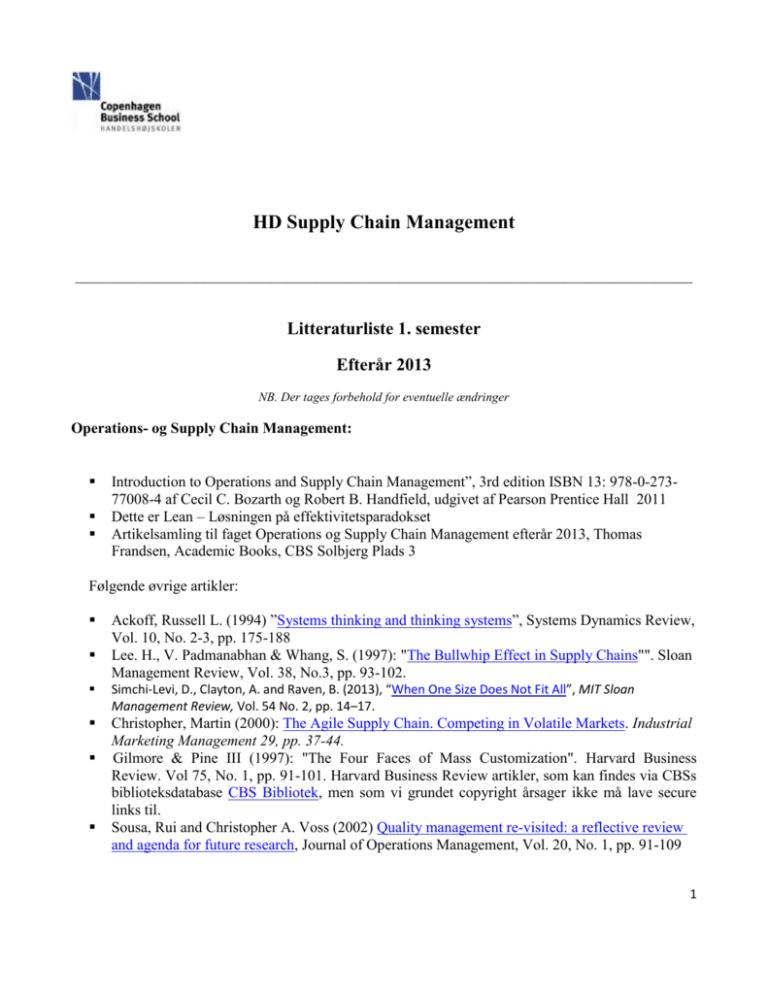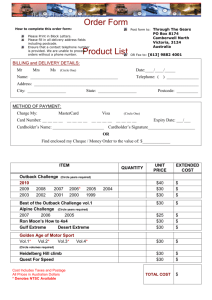
HD Supply Chain Management
__________________________________________________________________________________
Litteraturliste 1. semester
Efterår 2013
NB. Der tages forbehold for eventuelle ændringer
Operations- og Supply Chain Management:
Introduction to Operations and Supply Chain Management”, 3rd edition ISBN 13: 978-0-27377008-4 af Cecil C. Bozarth og Robert B. Handfield, udgivet af Pearson Prentice Hall 2011
Dette er Lean – Løsningen på effektivitetsparadokset
Artikelsamling til faget Operations og Supply Chain Management efterår 2013, Thomas
Frandsen, Academic Books, CBS Solbjerg Plads 3
Følgende øvrige artikler:
Ackoff, Russell L. (1994) ”Systems thinking and thinking systems”, Systems Dynamics Review,
Vol. 10, No. 2-3, pp. 175-188
Lee. H., V. Padmanabhan & Whang, S. (1997): "The Bullwhip Effect in Supply Chains"". Sloan
Management Review, Vol. 38, No.3, pp. 93-102.
Simchi-Levi, D., Clayton, A. and Raven, B. (2013), “When One Size Does Not Fit All”, MIT Sloan
Management Review, Vol. 54 No. 2, pp. 14–17.
Christopher, Martin (2000): The Agile Supply Chain. Competing in Volatile Markets. Industrial
Marketing Management 29, pp. 37-44.
Gilmore & Pine III (1997): "The Four Faces of Mass Customization". Harvard Business
Review. Vol 75, No. 1, pp. 91-101. Harvard Business Review artikler, som kan findes via CBSs
biblioteksdatabase CBS Bibliotek, men som vi grundet copyright årsager ikke må lave secure
links til.
Sousa, Rui and Christopher A. Voss (2002) Quality management re-visited: a reflective review
and agenda for future research, Journal of Operations Management, Vol. 20, No. 1, pp. 91-109
1
Sterman, John D. (2001): System Dynamics Modeling: Tools for Learning in a Complex World.
California Management Review, Vol. 43, No. 4, pp. 8-25
Powell, D. and Strandhagen, J.O. (2011), Lean production vs ERP systems: an ICT paradox?,
Operations Management, Vol. 37 No. 3, pp. 31–36.
Barratt, M. (2004), “Understanding the meaning of collaboration in the supply chain”, Supply
Chain Management: An International Journal, Vol. 9 No. 1, pp. 30–42.
Choi, T. and Linton, T. (2011), “Don’t Let Your Supply Chain Control Your Business”, Harvard
Business Review, Vol. 89 No. 12, pp. 112–117. Harvard Business Review artikler, som kan
findes via CBSs biblioteksdatabase CBS Bibliotek, men som vi grundet copyright årsager ikke må lave
secure links til.
Lindgreen, A., Vanhamme, J., van Raaij, E.M. and Johnston, W.J. (2013), “Go Configure: The
Mix of Purchasing Practices to Choose for Your Supply Base”, California Management Review,
Vol. 55 No. 2, pp. 72–96.
Sampson, S.E. & C.M. Froehle (2006): "Foundations and implications of a proposed Unified
Services Theory". Production and Operations Management, Vol. 15, No. 2, pp. 329–343.
Maull, R., Geraldi, J. and Johnston, R. (2012), “Service Supply Chains: A Customer
Perspective”, Journal of Supply Chain Management, Vol. 48 No. 4, pp. 72–86.
Pagh, J. D. and M. C. Cooper (1998): "Supply Chain Postponement and Speculation Strategies:
How to Choose the Right Strategy”. Journal of Business Logistics, Vol. 19, No. 2, pp. 13-33.
Litteraturliste 3. semester
Efterår 2013
NB. Der tages forbehold for eventuelle ændringer
Strategisk Indkøb:
Van Weele, A. (2010), Purchasing and Supply Chain Management, Cengage Learning, Fifth Edition.
Artikelsamling til faget Strategisk Indkøb efterår 2013, Kim Sundtoft Hald, Academic Books,
CBS Solbjerg Plads 3
Følgende øvrige artikler:
Kern, D. et al. (2011), Purchasing Competence: A Stakeholder-Based Framework for Chief Purchasing
Officers, Journal of Business Logistics, 32(2), side 122–138.
Nielse, B., Pedersen, T., & Pyndt, J. (2008), Ecco A/S – Global Value Chain Management, Richard Ivey
School of Business Foundation (Case)
Beall, S et al. (2003): ”The role of Reverse Auctions in Strategic Sourcing” CAPS Research [pp. 7-21,
68-73 (Volkswagen Group – case)
Bensaou, MM (1999), 'Portfolios of Buyer-Supplier Relationships', Sloan Management Review, 40, 4,
pp. 35-44
Narayanan V.G., Kulp, S. & Verkleeren, R.L. (2004), Metalcraft Supplier Scorecard, Harvard Business
School (Case), pp. 2-21.
2
O´Connor, N., Anderson, S. & Wu, A. (2011), Strategic Performance Measurement of Suppliers at HTC,
Asian Case Research Center, The University of Hong Kong (Case), pp. 1-13.
Handfield, R., Krause, D.R., Scannell, T.V:, & Monczka, R.M. (2000), Avoid the Pitfalls in Supplier
Development, Sloan Management Review, Winter, pp. 37-49.
Vaidya, K., Sajeev, A. M., & Callender, G. (2006). Chritical Factors that Influence E-procurement
Implementation Success in the Public Sector, Journal of Public Procurement, 6(1/2), pp. 70-99.
Supplier Relationships:
Ford, D. et al. (2011), Managing Business Relationships, Wiley, Third Edition
Følgende øvrige artikler:
Francis, I., Winter, N., & Vollmann, T. (2007), ABB and Caterpillar (A), Key Account Management,
IMD – International Institute for Management Development, Lausanne, Switzerland, pp. 1-8. (Case)
Francis, I., Winter, N., & Vollmann, T. (2007), ABB and Caterpillar (B) – The Renaissance, IMD –
International Institute for Management Development, Lausanne, Switzerland, pp. 1-4. (Case)
Hald, K.S., Cordon, C. and Vollmann, T.E. 2009, Towards an understanding of attraction in buyer–
supplier relationships, Industrial Marketing Management, Vol. 38, pp.
Christiansen, P.E. and Maltz, A. (2002), Becoming An “Interesting” Customer: Procurement Strategies
for Buyers without Leverage, International Journal of Logistics: Research and Applications, 5 (2), pp.
177-195* Uploads på Learn
Ellegaard, C., Vollmann, T., & Cordon, C. (2002), Freqon – Buyer-Supplier Evolution?, IMD –
International Institute for Management Development, Lausanne, Switzerland, pp. 1-13. (Case)
Cox, A., Lonsdale, C, Watson, G., & Wu, Y. (2005), Supplier relationship management as an
investment: evidence from a UK study, Journal of General Management, Vol. 30, No. 4, pp. 27-42.
Narayanan, V.G. and Ananth Raman (2004), Aligning Incentives in Supply Chains, Harvard Business
Review, 82 (11), pp. 94–102. Findes via CBSs biblioteksdatabase CBS Bibliotek, men som vi grundet
copyright årsager ikke må lave secure links til.
Wynstra, J.Y.F., Van Weele, A.J. and Weggemann, M. (2001), Managing Supplier involvement in
Product development: Three Critical Issues, European Management Journal Vol. 19, No. 2, pp. 157–
167.
Dyer, J. H. and Hatch, N.W. (2004), Using Supplier Networks to Learn Faster, MIT Sloan Management
Review, spring, pp. 57-63.
Cordon, C, Vollmann, T., & Vivanco, L. (2005), Numico (A) – Delivering innovation through the
supply chain, IMD – International Institute for Management Development, Lausanne, Switzerland,
pp. 1-10. (Case).
Hartley, J.L., Greer, B.M., and Park, S. (2002), Chrysler Leverages Its Suppliers' Improvement
Suggestions, Interfaces, Vol. 32, No. 4, July-August 2002, pp. 20-27
Boer, H., Kaltoft, R., Corso, M., Gertsen, F., Gieskes, J., Middel, R., & Steendahl Nielsen, J. (2005),
Factors affecting the development of collaborative improvement with strategic suppliers, Production
Planning & Control, 16(4), pp. 356–367. .* Uploads på Learn
Liker, J.K. and Choi, T.Y. (2004), Building Deep Supplier Relationships, Harvard Business Review,
December, pp. 104-113. Findes via CBSs biblioteksdatabase CBS Bibliotek, men som vi grundet
copyright årsager ikke må lave secure links til.
Spekman, R.E. (2001), Unitet Technologies Corporation Supplier Development Initiative, Darden
School of Business, pp. 1-15. (Case)
3
Lean og økonomistyring
Følgende øvrige artikler:
Jensen, K. B. (2013): ‘Lean Strategy – Three different perspectives’ Paper presented at EURoma
Conference on Operations Management, Dublin, – oploades på CBSLearn
International Logistik
Følgende øvrige artikler:
Fisher, M. (1997): What is the Right Supply Chain for Your Product? Harvard Business Review, Vol.
75, No.2, pp. 105-116. Findes via CBSs biblioteksdatabase CBS Bibliotek, men som vi grundet
copyright årsager ikke må lave secure links til.
Arnold, David (2000): Seven rules of International distribution. Harvard Business Review, Vol. 78, No.
6. Findes via CBSs biblioteksdatabase CBS Bibliotek, men som vi grundet copyright årsager ikke må
lave secure links til
New York Times, 29/04/2008: “Environmental Cost of Shipping Groceries Around the
World”,http://www.nytimes.com/2008/04/26/business/worldbusiness/26food.html?pagewanted
=all&_r=0
Butner, K., Geuder, D., and Hittner, J. (2008): “Mastering carbon management: Mastering trade-offs to
optimize supply chain efficiencies”. IBM Global Business Services. (Tilgængelig online via http://www05.ibm.com/de/automotive/downloads/mastering-carbon-management.pdf)
Information Management i Supply Chains
Jorge Verissimo Pereira, The University of Warwick, Coventry (2009) The new supply chain’s frontier:
Information management, International Journal of Information Management 29 (2009) 372–379.*
Simon R. Croom, (2005),"The impact of e-business on supply chain management: An empirical study of
key developments", International Journal of Operations & Production Management, Vol. 25 Iss: 1 pp.
55–73.*
Rashid, M.A., Hossain, L. and Patrick, J.D. (2001), The evolution of ERP systems. A historical
perspective, in: Entreprise resource planning – global opportunities & challenges, Idea group publishing,
pp. 1-16.*
Bernhard Wieder, Peter Booth, Zoltan P. Matolcsy, Maria-Luise Ossimitz, (2006),"The impact of ERP
systems on firm and business process performance", Journal of Enterprise Information Management,
Vol. 19 Iss: 1 pp. 13–29.*
Al-Mashari, M., & Zairi, M. (2000). Supply Chain re-engineering using enterprise resource planning
(ERP) systems: an analysis of SAP R/3 implementation case. International Journal of Physical
Distribution & Logistics Management. Vol. 30, No. 3/4. pp. 296-313.*
Hammer, M.(1990), Reengineering Work: Don’t Automate, Obliterate, Harvard Business Review, julyAugust. Kan findes på CBS Bibliotek.
Suresh Subramoniam, Mohamed Tounsi, K.V. Krishnankutty, (2009),"The role of BPR in the
implementation of ERP systems", Business Process Management Journal, Vol. 15 Iss: 5 pp. 653–668.*
Stebbins, M.W. & Shani,A.B.(1998), Business process reengineering at Blue Shield of California: the
integration of multiple change initiatives, Journal of Organizational Change Management, Vol.11,
No.3,1998.pp. 216-232*
4
Richard, J.E., et al.(2007) The strategic value of CRM: a technology adoption perspective, Journal of
Strategic Marketing15 421–439.*
Self, Richard (1990). Business Intelligence: developing a prototype in-house database, Business Review,
7:8.*
Popovic, A, et al (2010) Conceptual Model of Business Value of Business Intelligence Systems,
Management, vol.15,1, pp. 5-30.*
Misdolea, R. (2010) Decision Support System and Customer Relationship Management as Components
of the Cybernetic System Enterprise, Informatica Economica, vol. 14, no. 1.*
Louise Fletcher, Yiannis E. Polychronakis, (2007),"Capturing knowledge management in the supply
chain", EuroMed Journal of Business, Vol. 2 Iss: 2 pp. 191 – 207 (Supplerende literature).*
Premkumar, G. P. (2000). Interorganization Systems and supply chain management: An information
processing perspective. Information Systems Management. Summer. pp. 56-69.*
Gilles Neubert, Yacine Ouzrout and Abdelaziz Bouras (2004), Collaboration and integration through
information technologies in supply chains, International Journal of Technology Management, Vol. 28,
No. 2, 2004.*
Evgeniou, T. (2002). Information Integration and Information Strategies for Adaptive Enterprises,
European Management Journal, Vol.20,No 5, pp.486-494.*
Hammer, M. (2009). The Superefficient Company, Harvard Business Review, september 2009.*
Meyr, H., Wagner, M. and Rohde, J. (2002). Structure of Advanced Planning Systems (Chapter 5), in:
Supply chain management and advanced planning – concepts, models, software and case studies,
Springer–Verlag Berlin Heidelberg New York.*
Meyr, H., Rohde, J, Schneeweiss, L. and Wagner, M. (2002). Architecture of Selected APS (Chapter
17), in: Supply chain management and advanced planning – concepts, models, software and case studies,
Springer–Verlag Berlin Heidelberg New York (Supplerende litteratur).*
Paul Humphreys, Ronan McIvor, Trevor Cadden, (2006),"B2B commerce and its implications for the
buyer-supplier interface", Supply Chain Management: An International Journal, Vol. 11 Iss: 2 pp. 131–
139.*
Skjøtt-Larsen, T. et al. (2003). Electronic marketplaces and supply chain relationships.
Industrial marketing management 32. pp. 199-210.*
Taylor, J.C.(1998), Participative design: linking BPR and SAP with an STS approach, Journal of
Organizational Change Management, Vol.11, No.3,1998.pp. 233-245.*
Cecil Bozarth, (2006),"ERP implementation efforts at three firms: Integrating lessons from the SISP and
IT-enabled change literature", International Journal of Operations & Production Management, Vol. 26
Iss: 11 pp. 1223 – 1239.*
Kræmmergaard, P. (2005) ERP-systemer - Implementering og forandringsledelse, Børsen Forum A/S.
Børsen Ledelseshåndbøger, pp. 1-14.*
5





